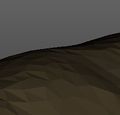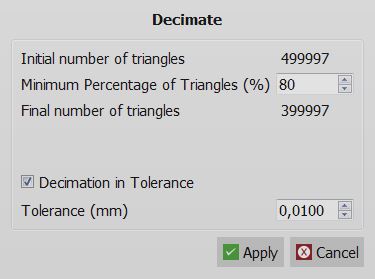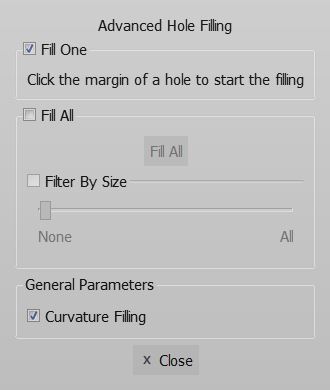Difference between revisions of "Man MeshEditing/it"
(Created page with "Lo strumento di affilatura liscia le parti planari della superficie e, allo stesso tempo, affila i bordi della mesh. Per eseguire questa operazione sono disponibili due parame...") |
(Created page with "# T [°] :questo angolo definisce cosa sia un bordo. Tutte le parti della superficie il cui angolo è minore a T° saranno affilate. Quando il valore è a 0, tutta la superfi...") |
||
| Line 28: | Line 28: | ||
Lo strumento di affilatura liscia le parti planari della superficie e, allo stesso tempo, affila i bordi della mesh. Per eseguire questa operazione sono disponibili due parametri: | Lo strumento di affilatura liscia le parti planari della superficie e, allo stesso tempo, affila i bordi della mesh. Per eseguire questa operazione sono disponibili due parametri: | ||
| − | # T [°] : | + | # T [°] :questo angolo definisce cosa sia un bordo. Tutte le parti della superficie il cui angolo è minore a T° saranno affilate. Quando il valore è a 0, tutta la superficie verrà lisciata |
| − | # | + | #Ripetizioni: il numero di volte che il software passerà sulla superficie per affilarla. Più il valore è alto, più la superficie verrà lisciata e affilata. |
'''The software applies this tool automatically, using specific parameters. The use of this tool with the wrong parameters may modify the shape and the dimension of the objects'''. | '''The software applies this tool automatically, using specific parameters. The use of this tool with the wrong parameters may modify the shape and the dimension of the objects'''. | ||
Revision as of 15:36, 20 October 2015
Contents
Modificare le Mesh
Una volt convertiti i dati in formato mesh, potrebbero essere necessarie alcune modifiche per renderle più idonee all'uso designato.
Le mesh potrebbero infatti avere difetti, rumori o buchi che devono essere compensati.
OpticalRevEng Dental applica automaticamente delle strategie di generazione delle Mesh specifiche a ogni elemento. Potrebbe però essere necessario modificare ulteriormente i dati prima di esportarle in un altro software.
Qui di seguito vengono descritti gli strumenti di Modifica delle Mesh, disponibili sia nel Menù Mesh o nella Barra degli Strumenti delle Mesh.
Rimuovi Picchi
Un picco in una mesh è per definizione una parte minuscola di superficie che non fa realmente parte dell'oggetto 3D scansionato.
In generale, i picchi vengono corretti automaticamente nel processo di generazione delle mesh ma, se le mesh vengono importate da un altro sistema, potrebbero essere presenti.
Questo strumento rimuove automaticamente i picchi e ripara la mesh.
Affilatura Mesh
Lo strumento di affilatura liscia le parti planari della superficie e, allo stesso tempo, affila i bordi della mesh. Per eseguire questa operazione sono disponibili due parametri:
- T [°] :questo angolo definisce cosa sia un bordo. Tutte le parti della superficie il cui angolo è minore a T° saranno affilate. Quando il valore è a 0, tutta la superficie verrà lisciata
- Ripetizioni: il numero di volte che il software passerà sulla superficie per affilarla. Più il valore è alto, più la superficie verrà lisciata e affilata.
The software applies this tool automatically, using specific parameters. The use of this tool with the wrong parameters may modify the shape and the dimension of the objects.
Mesh Smooth
This tool is similar to the Mesh Sharpening but it applies a smoothing to the whole surface, without preserving the edges.
The software applies this tool automatically, using specific parameters. The use of this tool with wrong parameters may modify the shape and the dimension of the objects.
Mesh Decimate
This tool reduces the number of triangles in a mesh, to save more space, trying to preserve as much detail as possible.
On the top is specified the current number of triangles of the selected meshes.
It is possible to insert a percentage of triangles to be kept (For example 50% to halve the mesh size).
It is also possible to establish a tolerance value. If the tolerance is enabled, the software will stop the decimation when this would modify the mesh more than the tolerance parameter.
Just click on Apply to see the result.
Mesh Defeature
This tool takes a selection of the mesh and it removes all the details, leaving the surface as plane as possible. It removes holes, spikes, noises. To use this tool:
- Select the area in which it is necessary to remove all the features with the Selection Tools
- Apply the Mesh Defeature
Make Manifold
This tool searches and removes the parts of the surface that are not Manifold. Look at: definition
Mesh Catenate
This tool can be used only in Free Mode. It takes all the selected meshes and creates a single mesh, merging all of the selected meshes together.
Flip Normals
Every mesh has an inside and an outside. The software gives them two different colors. This tool inverts the inside and the outside of the selected meshes.
Detect Intersections
Sometimes, it is possible that part of the surface of a mesh is intersected with the mesh itself, something that in reality is not possibile. This tool identifies this situation and fixes it.
Fill All Holes
This is an interactive tool that allows to fill the holes in the currently selected mesh.
This tool can work in 2 different ways
Fill One
In the fill one mode, the software will highlight the hole near the mouse cursor. By clicking with the left mouse button on the highlighted hole it will be filed.
Fill All
In the fill all mode, the software will try to close all the holes. With the Filter By Size function, it is possible to select all the holes below one size and fill them. The selected holes will be highlighted in real time by the sofware.
Curvature Filling
There is an additional option: curvature filling. If this option is enabled, the software will try to close the hole following the curvature of the rest of the surface. If it's disabled, the software will ignore the rest of the surface and close the hole with a straight plane.
Close Denture
When scanning a whole jaw, the base information will not be acquired. This tool has been created to recreate that information. Closing the dunture with the Fill All Holes tool takes too much time and the final result will not be good enough.
With the close denture tool, the mesh will be closed with a perfect plane in a reduced amount of time.
This tool will not work if the mesh has other holes or defects.
Mesh Cleaning
This removes all the possible defects and noises of a mesh.
Mesh Offset
This tool creates a bigger/smaller version of the selected mesh. The Offset [mm] parameter allows to select how much the mesh will change.
The three flags (Remesh, Sharpen and Optimize Vertices) have to be checked.
Usually, none of these tools is necessary to work because the strategies already apply a selected sequence of specific tools to each element.






